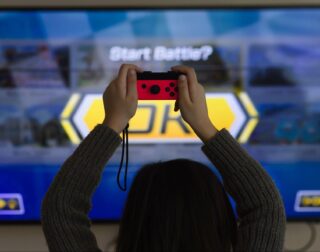This guest post was written by Penny Williams, “The ADHD Momma.” A “near ADHD-holic,” Penny is an author, blogger, and podcaster who has made it her mission to help parents through the tough, scary, and beautiful job of raising children with one or more diagnoses. Her website, Parenting ADHD, features online courses, videos, and her podcast of the same name. Her books include Boy Without Instructions: Surviving the Learning Curve of Parenting a Child with ADHD and The Many Layers of ADHD:The Underlying Complexities of ADHD and Their Powerful Effect on Your Parenting Success.
I’m curled up on the sofa, wrapped in a cozy blanket, finally relaxing for the day by watching reruns of the Big Bang Theory on TV. My atmosphere is peppered with muffled exclamations of excitement and enthusiasm — it’s my teen playing PlayStation VR with his friends back in the sunroom (i.e., gaming headquarters at casa de Williams).
You’d think I’d be annoyed that he’s breaking my quiet enjoyment. Or, maybe rolling my eyes about him finding video games so engaging and exciting in the first place. But, I’m not. Instead, it makes me smile. I enjoy hearing my son so joyful. You see, he has ADHD and “high-functioning” autism and learning disabilities. A lot of his life is really hard. He is faced with many challenges, daily.
When he was five years old, he was sad a lot. I mean most of the waking hours, seven days a week, 52 weeks a year. He couldn’t meet expectations no matter how hard he tried. He began to think he was “bad” or “broken.” This is at just five years old, folks.
A year later, we got a diagnosis of ADHD and started treatment. It has helped, but he still struggles, every day. He struggles with schoolwork, with sensory overload, with poor social skills, with being misunderstood.
School is like being sent to military boot camp for my son, knowing he’s enormously ill-suited for it, but having no choice at all but to be there. Just walking through the halls between classes can make him feel queasy and endangered. He has to work really, really hard to decode the intentions of his peers in every social exchange.
The struggle is real. It’s a tough life to live in a neurotypical world when you’re not neurotypical. So, when my son finds an activity that brings him joy, we embrace it. Gaming and technology offer him the most joy of anything he’s tried so far. It’s stimulation his ADHD brain craves, something he’s actually good at, simpler social interaction with peers (live chat playing the game together), and an activity that boosts his confidence and self-esteem. He even learns problem-solving skills in strategy games.
Technology is embedded in our culture. It’s here for the duration, so I embrace it. I simply refuse to join the collective wig-out over screen time.
Over the years we’ve created an understanding around screen time for our family. We won’t be crazed about the time he spends on it, if three conditions are met: (1) exceedingly violent and mature games are off-limits, (2) homework, physical activity, and other requirements get done, and (3) when we ask him to stop, he finishes up what he’s in the middle of and walks away or turns it off ASAP. It’s a delicate balance, and he does try to push the boundaries sometimes, but it works for us overall.
In fact, having time to explore technology has lead my son to recently discover that he likes making digital music, and is remarkably good at it. He creates strong, heavy beats that he has found actually soothe, calm, and center him. He’s enjoying it so much, he’s thinking of different careers he could work toward that would utilize these skills and further this interest.
Technology is embedded in our culture. It’s here for the duration, so I embrace it. I simply refuse to join the collective wig-out over screen time.
Let’s not forget technology can be a tool to work with and around disabilities and weaknesses, too. Technology has become a powerful tool in accommodating special needs in just the last 15-20 years alone. Non-verbal children (and adults) are using apps to communicate. Forgetful, disorganized students can use a smartphone or tablet to schedule assignments and activities and set alerts for reminders. Those who struggle with reading can have books and documents read aloud to them by their computer or device, to accommodate for conditions such as dyslexia and poor visual tracking.
My own son now has an iPad Pro he uses throughout his day at school. He captures worksheets and handouts in OneNote by taking pictures of the pages. He can then write on the digital copies with his Apple Pencil to complete the paper electronically. When finished, he emails the assignment to his teacher. There’s no longer paper to get crumpled and lost before it’s ever completed, much less turned in. He no longer has to do some assignments three and four times before they make it to his teacher. This one change has helped our family immensely.
That’s right, you won’t find me getting bent out of shape when my son’s been gaming with his friends for two hours straight. You won’t find me trying to quiet his enthusiasm — that is, unless he’s so loud the neighbors can hear him.
You will find me encouraging his use of technology and innovative/creative exploration. And you will, most definitely, find me reveling in his moments of joy — they’re priceless.
Featured image: Flickr user dogs & music






Emotional Freedom Tapping Helps refocus students. There is some theory behind it. Its a catchy tune and kids keep singing it. I love to hear “I am a happy child.”